PMC/PubMed Indexed Articles
Indexed In
- Open J Gate
- Genamics JournalSeek
- JournalTOCs
- China National Knowledge Infrastructure (CNKI)
- Electronic Journals Library
- RefSeek
- Hamdard University
- EBSCO A-Z
- OCLC- WorldCat
- SWB online catalog
- Virtual Library of Biology (vifabio)
- Publons
- MIAR
- Euro Pub
- Google Scholar
Useful Links
Share This Page
Journal Flyer

Open Access Journals
- Agri and Aquaculture
- Biochemistry
- Bioinformatics & Systems Biology
- Business & Management
- Chemistry
- Clinical Sciences
- Engineering
- Food & Nutrition
- General Science
- Genetics & Molecular Biology
- Immunology & Microbiology
- Medical Sciences
- Neuroscience & Psychology
- Nursing & Health Care
- Pharmaceutical Sciences
Review - (2019) Volume 10, Issue 4
A Review of the Geology and the Petroleum Potential of the Cretaceous Tano Basin of Ghana
Frederick Kofi Bempong1*, Bertram Maduka Ozumba1, Vincent Hotor2, Botwe Takyi3 and Cornelius S Nwanjide42Ghana National Petroleum Corporation (GNPC), Tema, Ghana
3Africa Centre of Excellence, Centre for Oilfield Chemicals Research (ACE-CEFOR), University of Port Harcourt, Nigeria
4Geoscan Technical Services Ltd, Awka, Nigeria
Received: 06-Jun-2019 Published: 07-Aug-2019
Abstract
This is a review of the geology and the petroleum potential of the Cretaceous Tano Basin of Ghana, one of the coastal sedimentary basins in Ghana. It is located on the West African Transform Margin. It initially evolved as a pull-apart basin and later became modified by wrench faulting in the Cretaceous period. It has been known to have potentials for hydrocarbons, as indicated by oils seeps observed in the late 19th century. The presence of active source rocks deposited in the Albian to Cenomanian as well as the Turonian charges the Upper Cretaceous reservoirs sealed by widespread marine shales, as well as faulted traps and pinch-outs, has spurred exploration efforts. Thus, as expected, commercial discoveries of oil and gas have been made in the Tano Basin which evidently has become a ‘hot cake’ in deepwater exploration, even though the ultradeep water could show even more exciting hydrocarbon plays.
Introduction
Ghana is located on the Gulf of Guinea, in the West African subregion, covering a land mass of about 238,500 km2 within latitudes 4º45`N and 11ºN, and longitudes 1º15`E and 3º15`W. The country falls within the Precambrian Leoman Shield of West Africa. The Eburnean orogeny which affected this Precambrian region spanned from 1.8 to 2.2 Ga and produced structurally and tectonically controlled succession of metavolcanics. These Precambrian metamorphites are overlain by supracrustal formations and intruded by younger granitoids. It is on these crystalline basement suites on the coast from Beninese region in the extreme southeast to Cote d’Ivoire in the extreme southwest corners of Ghana, that the coastal sedimentary basins are situated. A larger portion lies in the offshore setting, covering about 50,00 km2 and extending from the Cote d ’ Ivoire maritime border in the west to the Togo maritime border in the east [1,2]. The sedimentary facies lie on the Precambrian shield in broad, shallow basins to the north and in narrow, deeper basins along the coast. The rock types include shales, sandstones, conglomerates, and limestones, originally deposited in vast lakes, deltas, and shallow seas ranging in age from Ordovician to Pliocene. Three long periods of sedimentation are recognized, although each period contains phases of erosion.
However, most of the sedimentary basins are concentrated along the coast except the Voltaian basin, which is an inland basin. The Tano Basin is one of the three coastal Basin in Ghana (Figure 1).
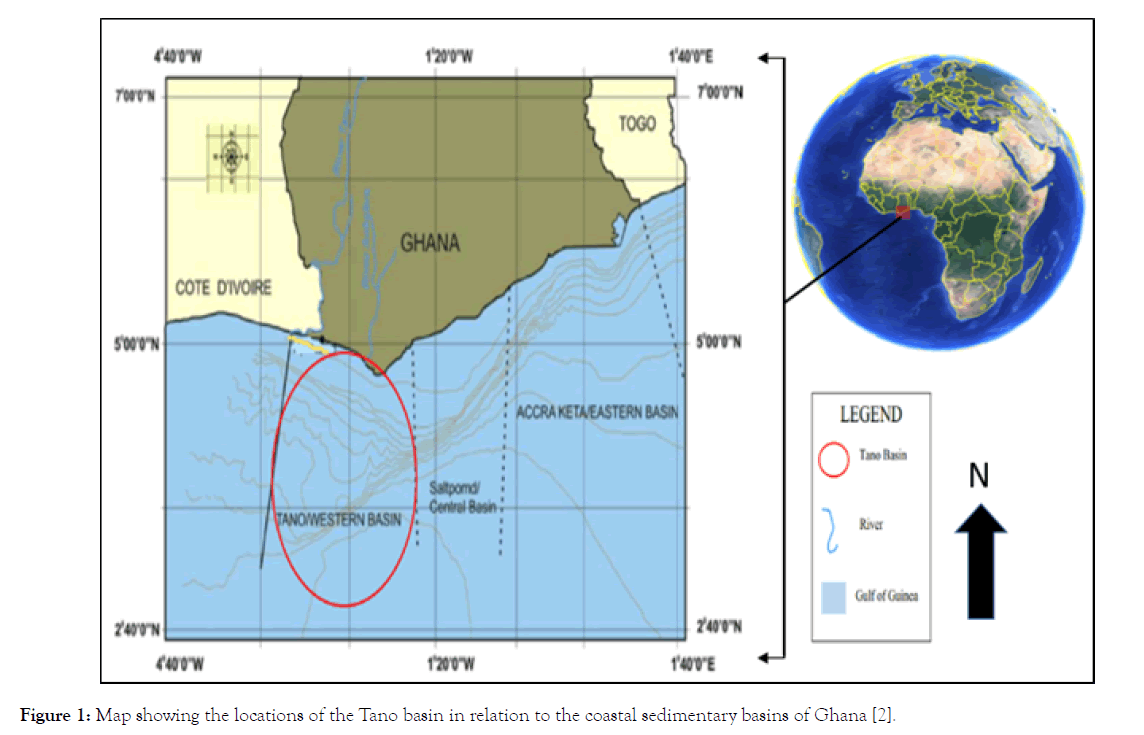
Figure 1: Map showing the locations of the Tano basin in relation to the coastal sedimentary basins of Ghana [2].
The Tano Basin is located in the West African Transform Margin (WATM) which occupies largely offshore and less onshore segments in the south western part of Ghana [3,4]. It encompasses the narrow Mesozoic coastal strip of south western Ghana, the continental shelf and steep submarine Ivory Coast- Ghana ridge which forms the continental slope [3]. It is also recognized as the eastern extension of Cote d’Ivoire – Ghana, an East-West onshore-offshore structural basin [5]. The combined factors of the absence of evaporites and halokinesis coupled with the influence of transform tectonics make the Tano Basin similar to its equivalents in the West African Transform Margin [6].
Literature Review
Tectonic evolution
The West African Transform Margin hosts the western basin of Ghana. The Tano Basin has undergone a series of tectonically driven evolutionary stages over geologic time expressed as continental to oceanic rifting in a grand scale transform fault [7]. The basin was initially a pull-apart basin in the late Jurassic epoch but was later modified by wrenching during the Cretaceous epoch (Figure 2). Three main WSW – ENE trending structures; St. Paul’s, Romanche and Chain fracture zones are recognized in the offshore setting in the Gulf of Guinea. However, these structures are stable tectonic flow lines which have contributed to the tectonic evolution of the Tano Basin. The tectonic complexity of the basin shows some sub-basin as a result of wrenching from some of the blocks offshore. An example is the thick foreland basin with characteristic compressive en-echelon folds and inverted syn-rift structures at the shelf break in the Cape three points deepwater block [8].
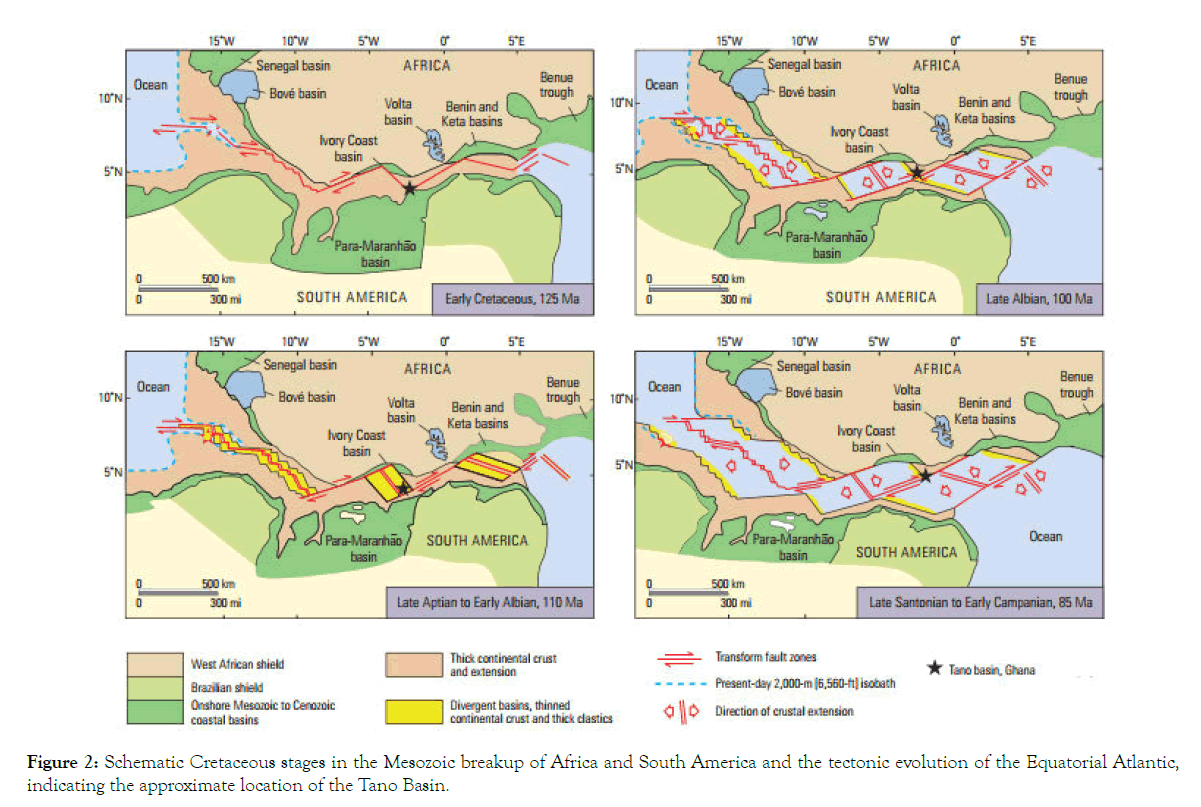
Figure 2: Schematic Cretaceous stages in the Mesozoic breakup of Africa and South America and the tectonic evolution of the Equatorial Atlantic, indicating the approximate location of the Tano Basin.
The Plate kinematic theory has been described to support the view of the initiation of the formation of the West African Transform margin [9]. Induced regional obliquity trends along the incipient plate boundary as the opening direction between the African and South American plates controlled the length and spacing of margin associated with the Tano Basin [10]. However, Attoh et al. [11] emphasized that the Côte d'Ivoire- Ghana transform margin formed from an ancient Pan African suture zone location, reflecting an inherited structure of the continental lithosphere.
Some Middle Jurassic rock has been recovered in the West African Transform Margin; thus, indicating that tectonic activity started no later than the Middle Jurassic [12]. Also Martin et al. [13] recognized Albian to Cenomanian volcanic activity as intrusions with encased sediments below the Upper Cretaceous turbidite systems in the Cote D’Ivore extension of the Tano Basin, this corroborates the fact that volcanic activities are associated with the drifting of the Atlantic Equatorial Margin. The late Jurassic marked the initiation of the West African Transform Margin as the African plate separated from the South American plate aided by seafloor spreading. Subsequent propagation of the rifting in the eastward direction initiated an oblique motion which translated to transform fault, subsidence, the fractures zone and subsequent sag that has been reflected as a tectonic imprint in the Tano Basin [14,15].
The southern part of Ghana, particularly the Tano Basin has been experiencing seismicity due to tectonic activities of the St. Paul ’ s and Romanche transform-fracture systems [16,17] highlighted the three main tectonic phases of the Tano Basin as follows:
Pre-Rift phase: It is characterized by rocks ranging in age from Precambrian to late Jurassic
Syn-Rift phase: It is characterized by Early Cretaceous age sediments. However, a major unconformity separates the Syn- Rift from the marine post-transform rocks of the uppermost Albian and Cenomanian.
Post-Rift phase: It is characterized by marine sediments from Cenomanian to present day.
Clearly, the creation of the onshore Ivory Coast and Tano Basins is related tectonically and co-incidentally Cretaceous in age and this coeval with the opening of the Atlantic mid-ridge and Ocean.
Sedimentology and stratigraphy
The opening and deepening of the South Atlantic Ocean created accommodation space which, with continental erosion, led to sediment deposition in the Tano Basin. Maximum depth to basement underlying the basin is not clear due to the dearth of drilling data. The Aptian is thought to be the commencement of deposition in the basin. According to Lee et al. [18] the Cenomanian/Turonian succession represents a post-rift/sag phase along the West African Transform Margin (WATM), following the Gondwana break-up. In general, the lithic fill of the basin consists of Cretaceous – Eocene marine sedimentary rocks comprising the eastern portion of a crescent – shaped body along the Atlantic coast in the southwestern part of Ghana and the southeastern Ivory Coast [19].
The Tano Basin is thought to have been supplied with the clastics by Rivers Ankobra (east direction) and Tano (western direction). These rivers were responsible for the deposition of a large turbidite reservoir in the slope to basinward direction [20]. Daily et al. [15] emphasise that in the Jubilee field (Figure 3), sediment feeds into the basin through the major entry point of the Turonian Canyon controlled by the structural configuration of the South Tano nose and Dixcove ridge. Kelly and Doust [21] highlighted the geological resemblance of the Tano Basin to Suriname-Guyana Basins in the Northeast-South-American margins. These features include the well-developed late Cretaceous erosional canyons. The coarse-grained shallow-water clastics enter the deep marine due to the sorting and transporting action of the strong longshore current along the continental shelf delivering coarse clastic sediments into the canyon heads. Brownfield and Charpentier [6] reported that the aggregate thickness of the fluvial and lacustrine sedimentary fill within the Tano Basin exceeds 6,000 m, concentrated north of the Romanche fracture zone, thus damming transportation and accumulation of sediments to the south.
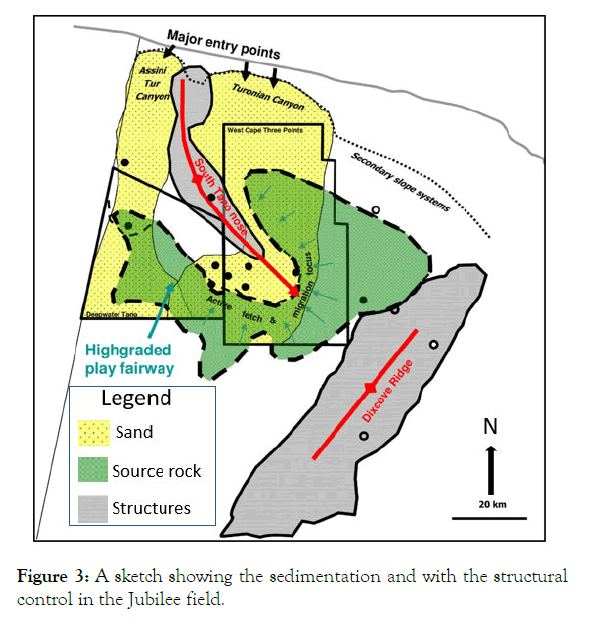
Figure 3: A sketch showing the sedimentation and with the structural control in the Jubilee field.
Davies [5] and the Ghana National Petroleum Corporation (GNPC) [22] described the stratigraphy of the Tano Basin as follows:
• Paleocene to Upper Miocene sequence
• Maastrichtian
• Lower Campanian to Upper Campanian
• Uppermost Santonian to Intra Lower Campanian
• Coniacian-Santonian
• Turonian
Cenomanian formation
• Upper Albian
• Uppermost Lower Albian-Middle Albian
• Lower-Middle Albian
• Aptian-Lower Albian
The stratigraphy of the Tano Basin outlined by the GNPC (Figure 4) has been modified by Daily et al. [15] (Figure 5). They emphasized that the basin has tectonically evolved from the Late Jurassic to the Pleistocene is reflected by the tectonic proves such as transtension, transpression, post-kinematics I and post-kinematics II.
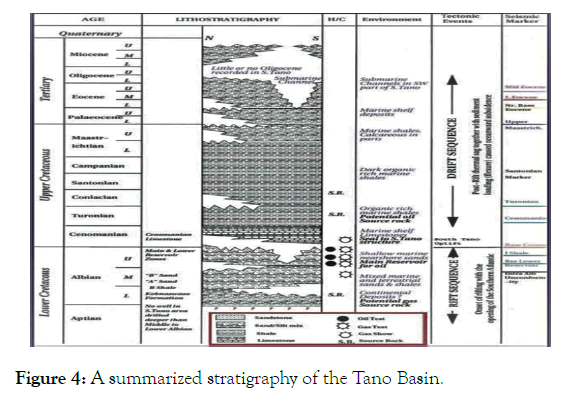
Figure 4: A summarized stratigraphy of the Tano Basin.
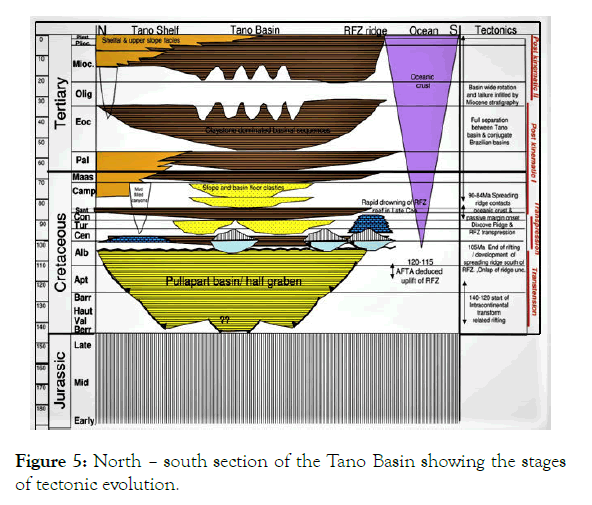
Figure 5: North – south section of the Tano Basin showing the stages of tectonic evolution.
Biostratigraphic studies have been carried out in the Tano Basin. Using palynological data (specifically dinoflagellate cysts) obtained from samples recovered from the Ocean drilling program on the Cote d ’ Ivoire continental margin, Sánchez- Pellicer et al. [23] proposed a biostratigraphic correlation for the Gulf of Guinea. Such an integrated approach has enhanced correlation within this province and decreased the error of placing the stage boundaries of biostratigraphic events. Atta- Peters et al. [24] carried out palynofacies studies using well data from Bonyere, western Ghana and established five palynofacies associations (I to V) based on the percentage relative abundances of the sedimentary organic matter. The palynofacies associations reflect deposition in a fluvio-deltaic (oxic) environment, a distal dysoxic-anoxic shelf environment, a proximal dysoxic-suboxic environment, nearshore (oxic) and a fluvio deltaic nearshore environment with high oxygen levels and low preservation rates.
Atta-Peters and Achaegakwo [2] discussed the palynofacies and paleo environmental significance of the Albian – Cenomanian succession onshore of the basin. Three palynofacies were identified as P-1, P-2 and P-3, the first two of which indicate a shallow marine environment deposits with some evidence of fluvio-deltaic deposits. The P-3 describes a fluvio-deltaic environment. The occurrence of the pollen forms Afropollis, Classopollis, Ephedripites elaterate and pteridophytic fern spores shows that the source plants thrived in a wetland of a humid and warm coastal plain in a semi-arid/arid climate. This agrees with the findings by Atta-Peters et al. [24] on sedimentary organic matter onshore Tano Basin. In a study in the offshore region, Atta-Peters and Salami [25] evaluated the late Cretaceous to Early Tertiary pollen with a keen interest in the miospores assemblage. The identified miospores assemblage indicated a freshwater swamp or marsh environment and also a warm and humid climate.
History of petroleum exploration in the Tano Basin
Hydrocarbon exploration in the Tano Basin started in the late 19th Century. Boateng [26] grouped the historical development into four (4) distinct phases, namely:
Initial phase – Onshore Exploration phase (1896 – 1969)
Second phase – Onset of offshore exploration (1970 – 1984)
Third phase – Inception of Ghana National Petroleum Commission (GNPC) (1985 – 2000)
Fourth Phase – Restructured and Refocused GNPC (2001 – date)
Oil seepages found by earlier explorers in the basin was the basis for drilling wells without seismic data and any geological understanding. Indeed, as far back as 1896, production from such wells was 5 BOPD. Eventual use of seismic data resulted in further, though non-commercial discoveries.
From 2000 to 2007 exploration shifted to deep water under partnership between GNPC and international companies using refined geologic models and concepts. The result was an estimated 312 ft net column of high-grade oil encountered in the Mahogany prospect of the West Cape Three Points License. This discovery formed the Jubilee field, with the name signifying a major commercial oil discovery after 50 years of Ghana ’ s independence.
The success story of the Jubilee field discovery in 2007, led to two more discoveries – the TEN field and Sankofa-Gye Nyame gas field (Figure 6). The TEN Field bears an estimated 300 MMbbl (80% of oil and 20% gas) in Turonian channel complex reservoirs. Sankofa-Gye Nyame gas field, located about 60 km offshore, in water depth ranging from 600 to 1000 m, holds an estimated reserve of 500 MBOE in Cenomanian sandstone reservoir and 270 MBOE of non-associated gas in Campanian Turbiditic sandstone reservoirs.
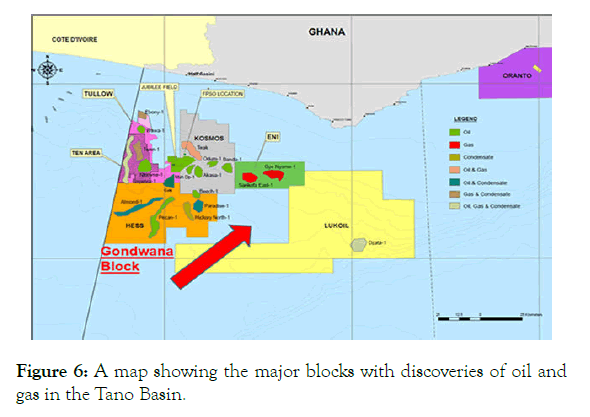
Figure 6: A map showing the major blocks with discoveries of oil and gas in the Tano Basin.
The petroleum system
The petroleum play of the Cretaceous Tano Basin (Figure 7) resulted from an active source rock, whose derivative oil and gas migrated to the reservoirs confined by a trap and seal, as defined by Magoon and Dow [27] and Al-Hajeri et al. [28] The play has three parts spanning Albian through Cenomanian to Turonian [4] with an extension into the Cote d’Ivoire region. The two working petroleum systems established from shallow to deep water is the Lower Cretaceous Syn-Atlantic rift system and the Late Cretaceous petroleum system [13].
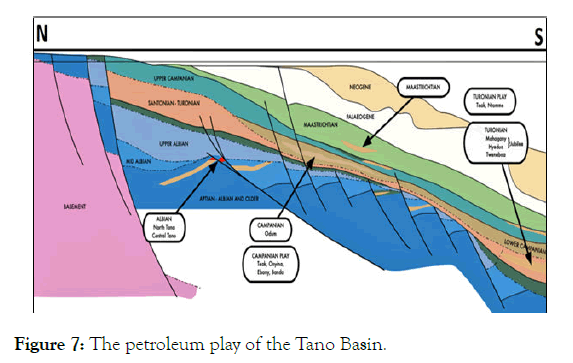
Figure 7: The petroleum play of the Tano Basin.
Source rock and hydrocarbon migration
The most significant hydrocarbon generation within the Gulf of Guinea petroleum province was from the Upper Albian and Cenomanian with the Turonian source rocks distributed present in the offshore Tano Basin [6]. The Ocean Anoxic Events (OAE) in the Cretaceous, was a continuous anoxic seaway in the late Albian to Turonian during the evolution of the West African Transform Margin [29,30]. This resulted in the deposition of Upper Albian and Cenomanian with Turonian black shale source rocks in the centre of the basin. The hydrocarbon generation that started in the Late Cretaceous period continues to the present day.
Well samples recovered from the deep-sea drilling site in both north and south of the West African Transform Margin have shown that these source rocks are characterized by more than 10% by weight of organic matter [6]. Oil kitchens in the deep waters, where the source rocks have a temperature of at least 100ºC and a vitrinite reflectance (Ro) of 0.6 percent were reported by MacGregor et al. [31]. According to Cameron and White [32] the principal play ingredients in the West African transform margin reflected in the Tano Basin are abundance of rich, commonly oil-prone, source rocks, young structuring, the recurrent presence of thick clean sands and ongoing hydrocarbon generation. Of all these ingredients, the regional development of source rocks is the most significant in their target succession [33].
Recent studies of the source rock potential of the basin by Atta- Peters and Garry [34] and Garry et al. [17] showed averagely good to excellent organic matter content. This corroborates the fact that there was a geological time span that promoted its production and preservation. The kerogen consisted of Types II and III, with some Type I and Type IV. Heat from the oceanic lithosphere had only a minor effect on the maturation history of the source rocks of the basin [7]. Furthermore, the thick Cenozoic section of the stratigraphy perhaps provided sufficient overburden to mature the Cretaceous source rock. Martin, et al. [13] noted that the volcanic activity associated with igneous intrusion enhanced the heat flow and may have substantially altered the local maturation of both the Apto-Albian continental and the Cenomano-Turonian marine source rocks, thus driving them into higher-maturity temperature windows seen in the western extension of the Tano Basin.
Reservoirs
In the late Cretaceous a deltaic complex deposited thick layers of basin floor fans and turbidity flows in the deepening Tano Basin. The large fan systems formed the main reservoirs in the Jubilee and Odum fields [35]. Most of the reservoirs are clastic (turbiditic sandstones) but there could be carbonate reservoirs at some levels of Aptian-Cenomanian age. Above the late Albian unconformity, thick and extensive sandstone units covering extensive areas in the deep water parts of the basin have been noted [31]. The steep nature of the continental shelf and the fact that it was subjected to several low stands along its margin, favoured the deposition of detached, deep-water sandstone units, clastic fans and ponded turbidite sands. The downslope projections of deltas that were formed at that time are therefore prospective for turbidite channel and ponded turbidite sandstone reservoirs. Large fans or detached sandstone bodies may lie in the deeper parts of the basin arising from the presence of these large turbidite channels. The reservoirs in the early post-transform section are likely to be of better quality than those in the syn-transform section [35]. In the Jubilee field offshore Ghana, the reservoirs are stacked Turonian sandstones with an average porosity of 21% and permeability of 700 mD [36]. They are blocky sands exhibiting characteristics of basin floor fans, as shown by the RMS (Root mean square) amplitude extraction in a channel complex fairway (Figure 8). Lee et al. [18] assessed the depositional controls of reservoir quality and deliverability within the Paradise and Hickory fields of the Tano Basin and inferred that the depositional architecture exerted a primary control on the quality of the stacked Cenomanian turbidite reservoirs.
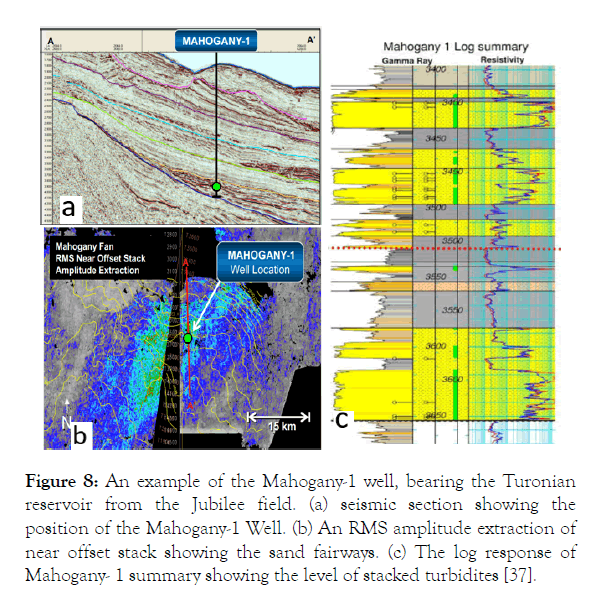
Figure 8: An example of the Mahogany-1 well, bearing the Turonian reservoir from the Jubilee field. (a) seismic section showing the position of the Mahogany-1 Well. (b) An RMS amplitude extraction of near offset stack showing the sand fairways. (c) The log response of Mahogany- 1 summary showing the level of stacked turbidites [37].
Seal and trapping Styles
The sealing units are commonly intraformational in occurrence, hemipelagic in origin, and are widespread in the basin. They are composed of marls, shales and clays. They are high integrity seals that prevent the further migration of the hydrocarbons beyond the reservoir rocks. The seals associated with syn-transform reservoirs are formed by both shales and faults, whereas those associated with post-transform reservoirs are generally shales. This is especially evident in places where the shelf is steeper, and there is a greater probability for the occurrence of detached sandstone units and up-dip seals [6].
The Tano Basin exhibits both structural and stratigraphic traps. The proven accumulations of hydrocarbons associated with fault-block traps are located in the upper part of the syn-transform section throughout the Gulf of Guinea Province in shallow to moderate water depths [31]. This type of trap is characteristic of the Tano field and extends onto the continental slope. There are also fault-block traps located along the Romanche Fracture Zone. Post-transitional anticlinal traps are also present in the Tano Basin.
In the Turonian reservoir of the Jubilee field, the trapping configuration is both structurally and stratigraphically controlled (Figure 9). The Cenomanian play also bears structural and stratigraphic traps associated with clastic depositional lenses, draping structure, pinch-outs, and fault assisted anticlines [38, 39]. The Cenozoic deposits have not proved productive probably due to insufficient trap size not warranting exploration [34].
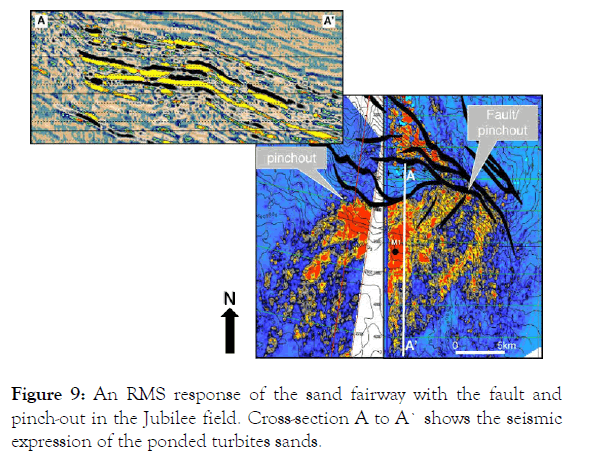
Figure 9: An RMS response of the sand fairway with the fault and pinch-out in the Jubilee field. Cross-section A to A` shows the seismic expression of the ponded turbites sands.
Conclusion
The Tano Basin is a part of the West African Transform margin (WATM). It evolved initially as a pull part basin but was later modified by wrenching. The wrenching tectonics resulted in some localized sub-basin variations such as the foreland basin type. Sedimentation followed the separation of the South American plate and African plate, with the deposition of marine source rocks in an anoxic condition which favoured the maturation as well as the emplacement of large turbidite reservoirs. The basin thus has a working petroleum system indicated by oil seeps noted in the 19th century. Active source rocks deposited in the Albian to Cenomanian in addition to that of Turonian charges the localized Upper Cretaceous reservoirs sealed by widespread intraformational marine shales aided by faulted traps and pinch-out have favoured exploration efforts. Thus, discoveries of petroleum play in which three oil and gas fields have been advanced to production. The deepwater portion of the basin, about 60 km offshore, with water depth greater than 100 m, has very high hydrocarbon potential. This makes the Tano Basin a ‘hot cake’ in deepwater exploration. The ongoing exploration indicates that the ultra-deepwater could show very exciting hydrocarbon play.
REFERENCES
- Adda G. The Petroleum Geology of Ghana. Petroleum Commission Newsletter, GH-Upstream News. 2014;1:2-6.
- Al-Hajeri MM, Al-Saeed M, Derks J, Fuch T, Hantschel T, Kauerauf A, et al. Basin and petroleum system modelling. Oil field review. 2011;32:14-29.
- Aryeetey MN. Unlocking the Hydrocarbon Potential of the Ultra-Deepwater Basins offshore Ghana, An article on the workshop organized by Oil and Gas Event. 2013.
- Atta-Peters D, Achaegakwo CA. Palynofacies and palaeo environmental significance of the Albian Cenomanian succession of the Epunsa-1 well, onshore Tano Basin, western Ghana. J Afr Earth Sci. 2016;114:1-12.
- Atta-Peters D, Agama CI, Asiedu DK, Apesegah E. Palynology, palynofacies and palaeoenvironments of sedimentary organic matter from Bonyere – 1 Well, Tano Basin, western Ghana. International Letters of Natural Sciences. 2013;5:27-45.
- Atta-Peters D, Garrey P. Source rock evaluation and hydrocarbon potential in the Tano Basin, South Western Ghana, West Africa. Int J Oil Gas Coal. 2014;2:66-77.
- Atta-Peters D, Salami MB. Late Cretaceous to early Tertiary pollen grains from offshore Tano Basin, Southwestern Ghana. Revista Española de Micropaleontología. 2004;36:451-465.
- Attoh K, Larry B, Haelein J. The role of Pan-African structures in intraplate seismicity near the termination of the Romanche fracture zone, West Africa.
- Basile C. Transform continental margins – Part 1: Concepts and models. Tectonophysics. 2015;661:1-10.
- Blarez E, Mascle J. Shallow structures and evolution of the Ivory Coast and Ghana transform margin: Mar Petrol Geol. 1988;5:54–64.
- Boateng MO. Oil exploration and production in Ghana. National Forum on Oil and Gas development, GIMPA, Accra – Ghana. 2008.
- Brownfield ME, Charpentier RR. Geology and total petroleum systems of the Gulf of Guinea Province of West Africa: USA. Geological Survey Bulletin. 2006;2207:1-39.
- Cameron NR, White K. Exploration opportunities in offshore deepwater Africa. IBC ‘Oil and Gas Developments in West Africa’, London.1999.
- Dailly P, Henderson T, Hudgens E, Kanschat K, Lowry P. Exploration for Cretaceous stratigraphic traps in the Gulf of Guinea, West Africa and the discovery of the Jubilee Field: a play opening discovery in the Tano Basin, Offshore Ghana. Geological Society, London. 2012;369:3.
- Davies DW. The Geology and Tectonic Framework of the Republic of Ghana and the Petroleum Geology of the Tano Basin. Southwestern Ghana. Unpublished consultancy report prepared for Petro-Canada International Corporation on behalf of GNPC. 1986;pp. 24.
- Dumestre MA. Northern Gulf of Guinea shows promise. Oil Gas J.1985;83:154–165.
- Garry P, Atta-Petters D, Achaegakwo C. Source - rock potential of the lower Cretaceous sediments in SD – 1x well, offshore Tano Basin, southwestern Ghana. Petroleum and Coal. 2016;58:476-489.
- Ghana National Petroleum Cooperation. Southern Ghana Regional Biostratigraphic and Geochemical Review. Report Number 5322. Robertson Research International Ltd, U.K. 1998;1:153.
- Jenkyns HC. Geochemistry of oceanic anoxic events.
- Kelly J, Doust H. Exploration for the late Cretaceous turbidites in the Equatorial African and Northeast South American margins. Neth J Geosc.2016;95:393-403.
- Kesse GO. The mineral and rock resources of Ghana. A.A. Balkema, Rotterdam, Boston. 1985.
- Kutu MJ. Seismic and tectonic correspondence of major earthquake regions in Southern Ghana with Mid-Atlantic Transform-Fracture Zones. Int J Geo Sci. 2013;4:1-7.
- Lee M, Cox P, Cheshire O, Pluim S, Nyamaah LA. Reservoir characterization of the paradise and hickory discoveries offshore Ghana: Integration of Depositional and Digenetic Concepts: Search and Discovery. 2014.
- MacGregor DS, Robinson J, Spear G. Play fairways of the Gulf of Guinea transform margin. In T. M. Arthur, Petroleum geology of Africa—New themes and developing technologies: Geological Society London, UK. 2003;207:289.
- Magoon LB, Dow WG. The petroleum system: From source to Trap. American Association of Petroleum Geologist Memoire. 1994;60:3-24.
- Mah G. Geological evaluation of the onshore North Tano Basin. PAC/GNPC report.1987.
- Marion DL, Lies L, Christophe B, Walter R, Martin P, Agnes M, et al. Transform continental Margins Part 2: A world review. Technophysics. 2016;693:96-115.
- Martin J, Duval G, Lamourette L. What lies beneath the deep-water Tano Basin? Hunting for Jubilee-like prospects in Côte d’Ivoire. GEO Expro magazine.2015;12:1-108.
- Nora Herbst IA, Daily P, Dribus JR, Fainstein R, Harvey N, McCoss A, et al. Basin to Basin: Plate Tectonic in Exploration: Oilfield Review Autumn. 2012;3:38-68.
- Rüpke LH, Schmid DW, Hartz HE, Martinsen B. Basin modelling of a transform margin setting: structural, thermal and hydrocarbon evolution of the Tano Basin, Ghana. Pet Geosci. 2010;16:283-298.
- Sánchez- Pellicer R, Masure E, Villier L. A new Biostratigraphic Correlation for Late Cretaceous–Paleocene Strata of The Gulf of Guinea: Evidence from Dinoflagellate Cysts. C R Geosci. 2017; 349:32-41.
- Schiefelbein CF, Zumberge JE, Cameron NR, Brown SW. Petroleum Systems in the South Atlantic Margins. The Oil and Gas Habitats of the South Atlantic. Special Publication of the Geological Society.1999;153:169-180.
- Sills S, Agyapong D. Jubilee Field Description and water flood performance overview. A paper presentation at the Offshore Technology conference held in Houston, Texas, USA. 2012.
- Tetteh, JT. The Cretaceous Play of Tano Basin, Ghana. Int J Appl Sci Technol. 2016;6:1-10.
- Tissot B, Demaison G, Masson P, Delteil JR, Combaz A. Paleoenvironment and petroleum potential of middle Cretaceous black shales in Atlantic basins: American Association of Petroleum Geologists Bulletin.1980;64:2051-2063.
- Vanco Ghana Ltd. Final Geologic well report: Cheetah-1X. 2012;11.
- Whaley J. Gold Coast to Black Gold. GeoExpro. 2010;7: 46-48.
- Doust H. The exploration play: What do we mean by It? American Association Petroleum Geologist bulletin . 2010;11:1657-1672.
- Yang R, Wang Y. Cretaceous source rocks and associated oil and gas resources in the world and China: A review. Petroleum Science. 2014;11:331-345.
Citation: Bempong FK, Ozumba BM, Hotor V, Takyi B, Nwanjide CS (2019) A Review of the Geology and the Petroleum potential of the Cretaceous Tano Basin of Ghana, J Pet Environ Biotechnol 10. 395. DOI: 10.35248/2157-7463.19.10.395
Copyright: © 2019 Bempong FK, et al. This is an open-access article distributed under the terms of the Creative Commons Attribution License, which permits unrestricted use, distribution, and reproduction in any medium, provided the original author and source are credited.

